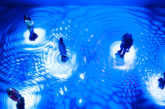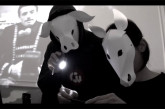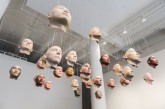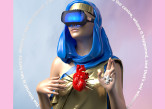“(…) But perception operates only upon difference. (…)
Knowledge at any given moment will be a function of the thresholds
of our available means of perception.” (Gregory Bateson,
“Every Schoolboy knows…”, in Mind and Nature, 2004.
Available at http://www.oikos.org/m&nschoolboy.htm)
I WOULD LIKE TO INVITE YOU TO TAKE A LOOK AT ESCHER’S Day and Night . What does this mean to you? What pattern connects day and night in this image? Do questions need to have answers?
Despite the fact that the conventional pattern in our Western culture is to give an answer to a question, I would like to invite you now to put this pattern in parentheses so as to allow yourselves to perceive the other possibilities questions can provide – i.e. to perceive other patterns which can be just as valid as the one we truly believe to be the only valid pattern, or to see that the validity of a certain pattern is always situated and dependent on social agreement, or to notice that different patterns can coexist in a dynamic flow as illustrated in the picture of birds flying to the left and/or to the right – which direction are they really flying?
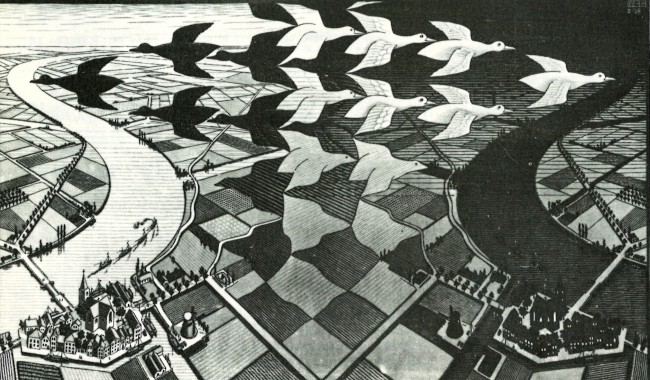
In fact, an ‘answer’ depends on our socio-historic positions we assume within the social practices we embrace; while leaving this question open/unanswered can provide us with the motivation to reflect on the different patterns that constitute our everyday lives, and avoid the creation of o p p o s i t i o n s between these patterns.
The purpose of this article is to entice reflection on cultural categorizations that teach us to see the world as a binary dis-junction, where difference has little or no room to exist, and to broaden our view to the interconnectedness of different patterns as a necessary condition to exist as the same beings: human beings situated in different, valid cultures.
1+1=3
We have all been conditioned to categorize the world in binary op-positions: good vs. bad, virtual vs. real, pre-something vs. post-something, I vs. You, and same vs. different. Such categorizations, however, are socially constructed. Moreover, they indicate much more about the values their interpretative communities exalt, than they do about the things or situations being categorized. But to what degree are these communities different from the categorized entities? Aren’t they simply the reflection of each other? Let us take the example of virtuality, a social phenomenon traditionally opposed to the category of ‘real reality’ and associated with the advent of digital technology, which now exposes us to a dynamic flow of information which goes beyond the chronological organization of space and time.
Instead of an opposition to ‘real reality’, virtuality can be seen as a ‘real’ gateway into another order which is distinct from that of the material Cartesian chronological world, though (paradoxically) created within that ‘same’ world. By putting these concepts in parentheses, in my previous research , I claimed that through virtuality (as real as the ‘real reality’) we can see a world structured by the pattern of a visual order – that is to say, a pattern based on the simultaneity of spaces, time, senses, and identities, along with an organization guided by affinities (as in virtual communities, for example).

It is no wonder then that when placed in the social practices structured by the hierarchical, materialistic rules, we once saw virtuality as the dissolution of this Cartesian reality – such (apparent) disjunction only makes sense if we use the pattern of this chronological world (where 2 comes after 1 or yesterday comes before today and tomorrow, or geographic boundaries mark crystal clear distinctions and/or put together the ones that are alike) to understand a pattern of a visually organized world. However, we need to counterpose such patterns to try to understand how different they/we are and how such differences can enable changes or broaden our categorizations or even make another pattern emerge, where one pattern plus another pattern leads to a third (distinct) pattern (not a synthesis).
Let us take the role of the image in our culture. Traditionally taken as a self-explanatory illustration (in relation to a written text) or as a proof of a situation (especially a photograph), the image reflects the patterns of symbolic systems which are socially agreed upon and, at the same time, it also reflects our localized means of perception or the limits of our interpretation, as is the case of the following picture of a pollen from a morning-glory. So, to what extent are we interested in putting our systems in parentheses in order to perceive other systems? To what extent does this image produced by a scanning electron microscope help us broaden (or reinforce?) our (traditional) categorizations of reality?
Final Remarks
“The culture (…) has traditionally used pieces of art or ritual as samples or probes to reveal particular psychological themes or states. The question has been: Does the art tell us about what sort of person made it? But if art, (…), has a positive function in (…) correcting a too purposive view of life and making the view more systemic, then the question to be asked of the given work of art becomes: What sorts of correction in the direction of wisdom would be achieved by creating or viewing this work of art? The question becomes dynamic rather than static.” (Gregory Bateson, Steps to an ecology of mind. Chicago: University of Chicago Press, 2000, pp. 146-147)
I would like to finish this article with the fractal image above.
From this systemic perspective, the coexistence of patterns becomes a question of positions, not of oppositions, in fact, a question of social compositions. Where are we situated within this fractal world? To which patterns are we all connected?
Glauce Rocha de Oliveira
(1) In line with the work of Humberto Maturana, to put a value in parentheses is a way to understand different values not as a threat but as a valid part of a greater Whole we all belong to (Humberto Maturana. Cognição, Ciência e Vida Cotidiana. Belo Horizonte: Editora UFMG, 2001).
(2) Glauce Rocha de Oliveira. 2008. Sobre o Azul do Mar: Virtualidades Reais e Realidades Virtuais (On the Blue of the Sea: Virtual Realities and Real Virtualities). PhD. University of São Paulo (FFLCH). Available at: http://www.dominiopublico.gov.br/pesquisa/Detal heObraForm.do?select_action=&co_obra=107928

